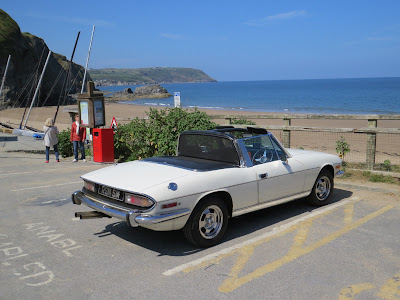As you might expect this bolt is done up very tight, I think from memory 150PSI and as you might also expect takes a bit of undoing. My car is an automatic and that causes a problem as it is not possible to lock the crankshaft to stop it turning when trying to undo this bolt. The Stag Forum offers various solutions, to either lock the crankshaft or to shock the nut undone. Some of the suggestions I thought were a bit risky, so I opted for the tried and tested option, which required a very long lever and socket and a 18 inch Stillson wrench.
In the past when I needed extra leverage I slipped the handle of a long defunct bottle jack over the lever of my 1/2 inch socket set, effectively doubling it's length, but for this job I decided I needed the proper tool. My local motor accessory shop did me proud by selling me a 24 inch breaker bar from STAG TOOLS, how appropriate is that. The other tool needed is a very large wrench and although I tried all the nearby tool stores to no avail, I eventually got a decent second hand Record Stillson type wrench from an EBay seller.
The procedure was to adjust the Stillson as tightly as possible around the large circular part to the rear of the pulley block and with the handle resting on a block of wood which in turn rested on the chassis rail, the wood was to spread the load so as not to damage the chassis rail.
With the correct socket and the long leverage of the breaker bar apply the necessary pull to undo the bolt. The thing about a Stillson type wrench is that the more pressure you apply the tighter the teeth bite and without any drama, pings or sudden clicks the bolt just started to undo, brilliant.
For only the second time I deployed my large gear puller and again the pulley block easily slipped of the shaft, exposing the key left in the crankshaft and the corresponding keyway in the pulley.
Nothing now preventing me from removing the timing chest cover in the New Year and replacing the timing chains. In between while I have been gradually rubbing down the red Hammerite paint on the right hand side of the engine bay, slow work but getting there, that is cold work, but I do want to complete this messy job before I do anything else.






















































